Financial Analysis of Laolu & Company and Kwaku Ltd: A Finance Report
VerifiedAdded on 2023/01/13
|9
|1960
|32
Report
AI Summary
This report provides a comprehensive analysis of financial statements and costing methods, focusing on Laolu & Company and Kwaku Ltd. The report begins with an introduction to finance and its principles, emphasizing the importance of accurate financial statements. Component 1 details the preparation of income statements and balance sheets for Laolu & Company, including the presentation of financial data and calculations of key financial metrics. Component 2 then shifts its focus to Kwaku Ltd, examining various financial transactions and their impact on the company's financial position, including assets, liabilities, and equity. The report also covers the application of absorption and marginal costing techniques, comparing their results and implications for decision-making. The conclusion summarizes the key findings and reinforces the significance of adhering to financial principles for effective financial reporting and analysis. References to relevant literature are also included, providing additional context and support for the analysis.
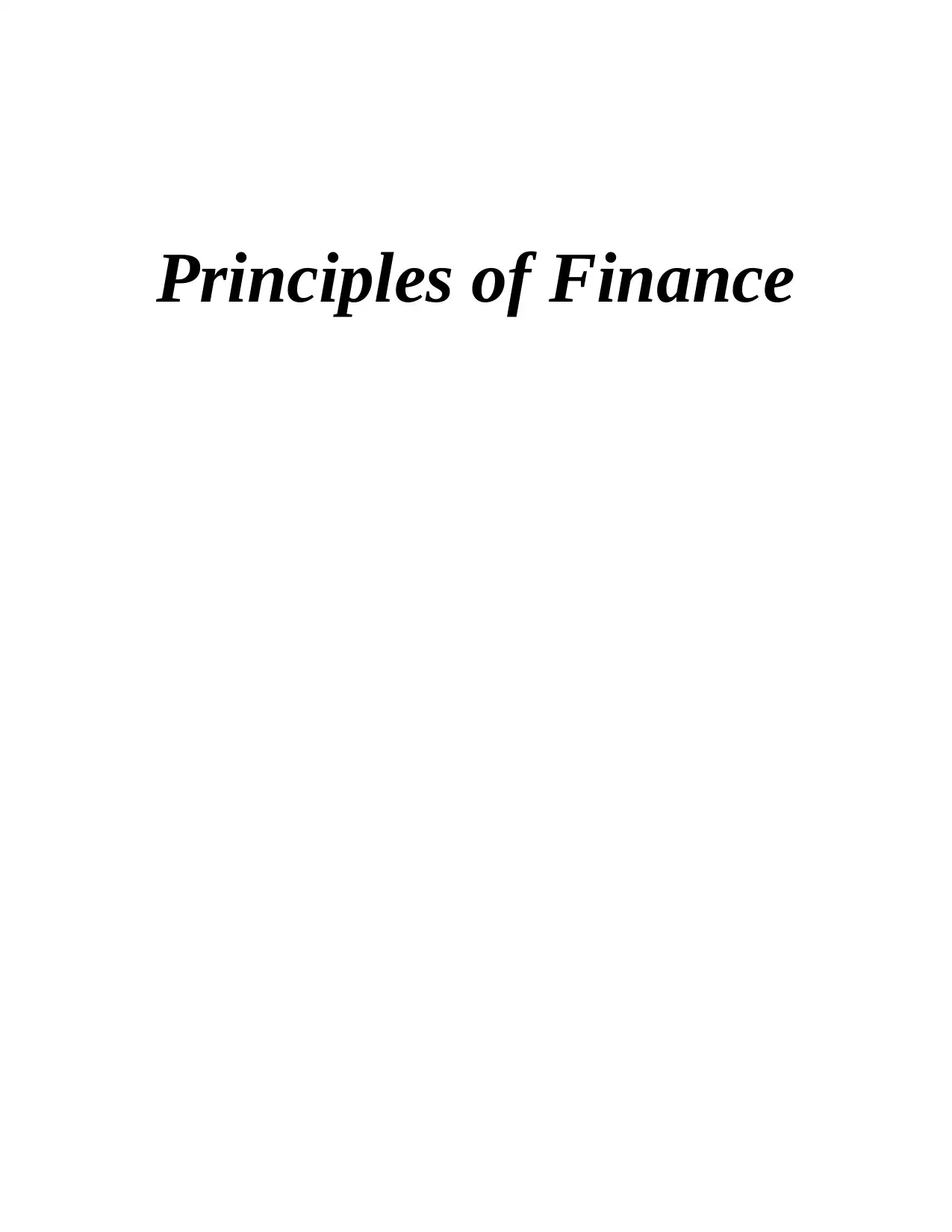
Principles of Finance
Paraphrase This Document
Need a fresh take? Get an instant paraphrase of this document with our AI Paraphraser
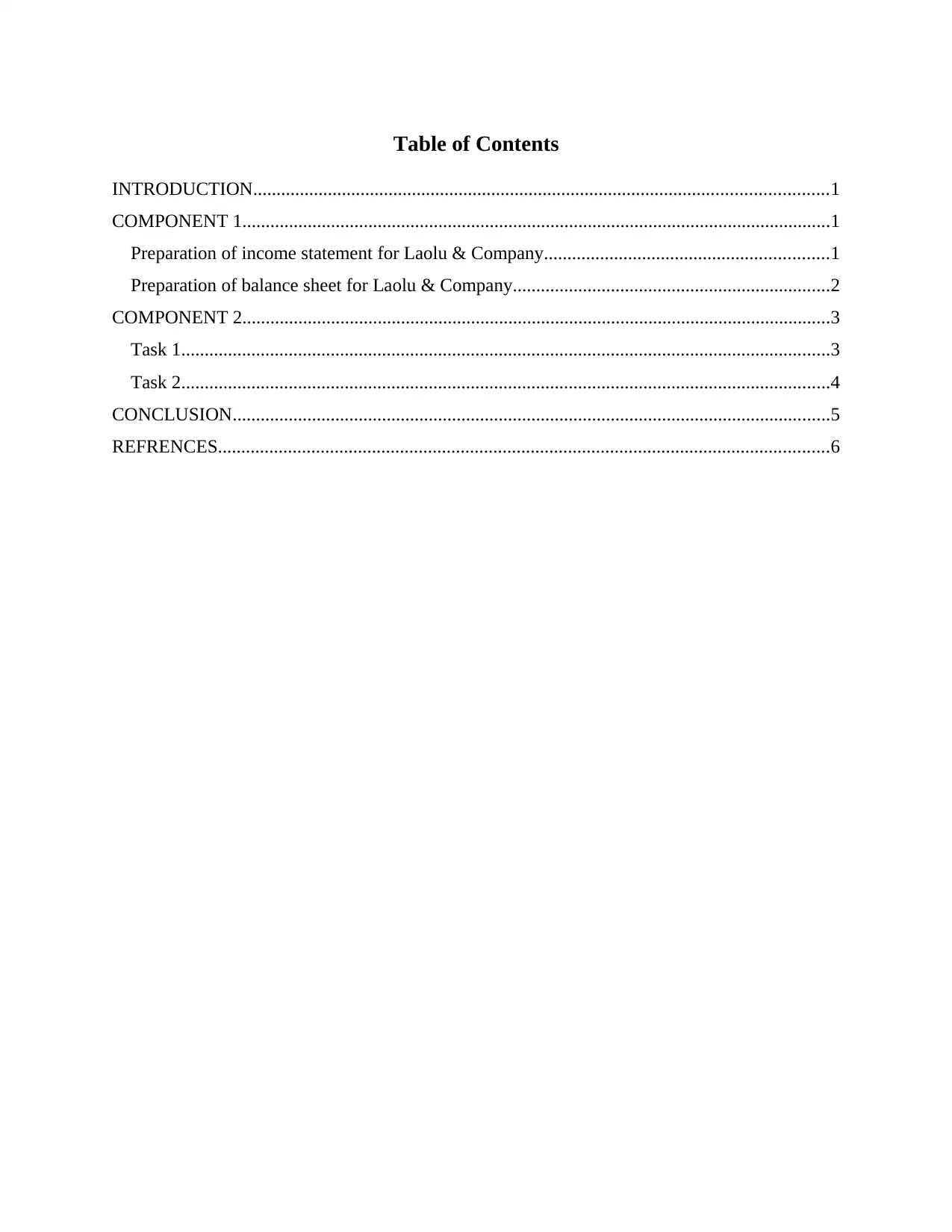
Table of Contents
INTRODUCTION...........................................................................................................................1
COMPONENT 1..............................................................................................................................1
Preparation of income statement for Laolu & Company.............................................................1
Preparation of balance sheet for Laolu & Company....................................................................2
COMPONENT 2..............................................................................................................................3
Task 1...........................................................................................................................................3
Task 2...........................................................................................................................................4
CONCLUSION................................................................................................................................5
REFRENCES...................................................................................................................................6
INTRODUCTION...........................................................................................................................1
COMPONENT 1..............................................................................................................................1
Preparation of income statement for Laolu & Company.............................................................1
Preparation of balance sheet for Laolu & Company....................................................................2
COMPONENT 2..............................................................................................................................3
Task 1...........................................................................................................................................3
Task 2...........................................................................................................................................4
CONCLUSION................................................................................................................................5
REFRENCES...................................................................................................................................6
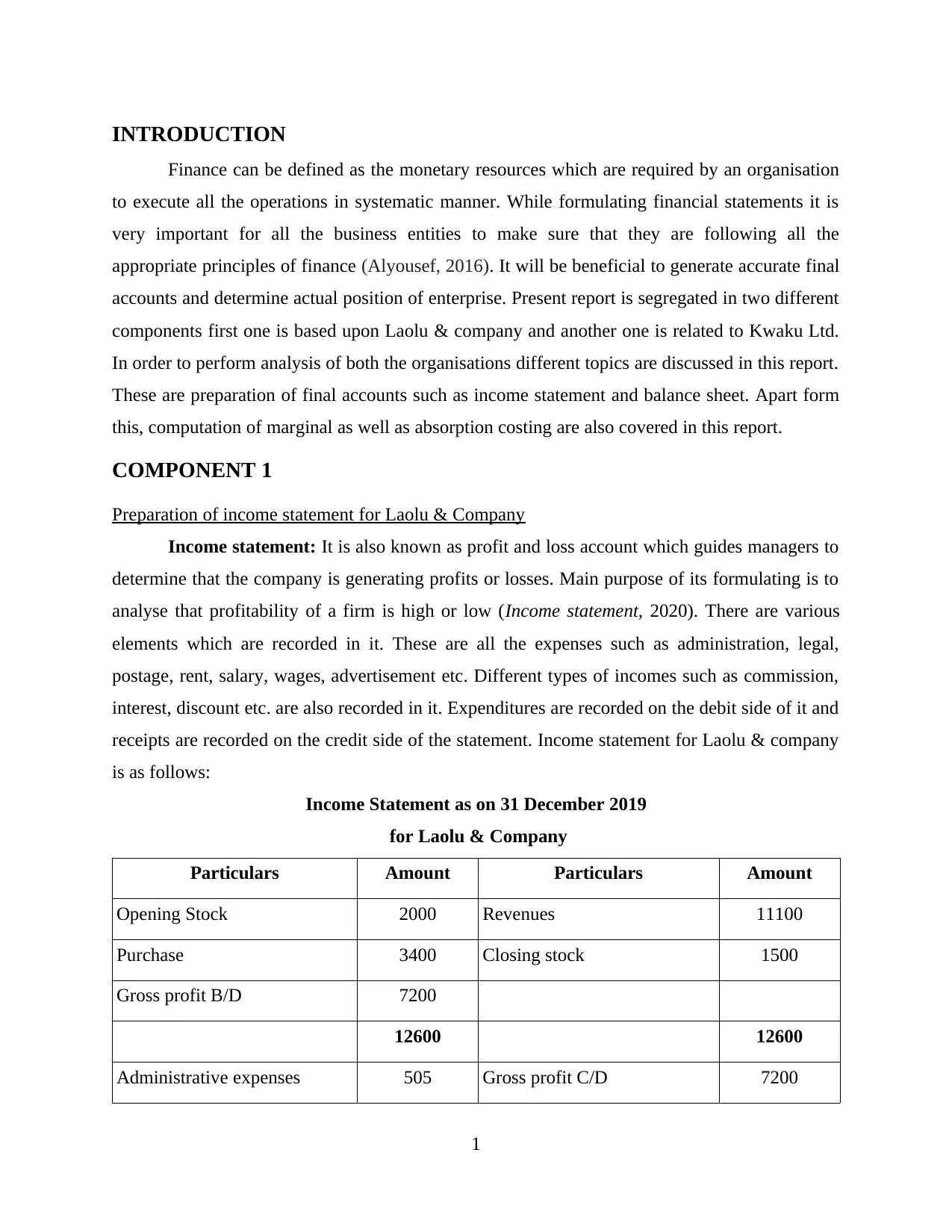
INTRODUCTION
Finance can be defined as the monetary resources which are required by an organisation
to execute all the operations in systematic manner. While formulating financial statements it is
very important for all the business entities to make sure that they are following all the
appropriate principles of finance (Alyousef, 2016). It will be beneficial to generate accurate final
accounts and determine actual position of enterprise. Present report is segregated in two different
components first one is based upon Laolu & company and another one is related to Kwaku Ltd.
In order to perform analysis of both the organisations different topics are discussed in this report.
These are preparation of final accounts such as income statement and balance sheet. Apart form
this, computation of marginal as well as absorption costing are also covered in this report.
COMPONENT 1
Preparation of income statement for Laolu & Company
Income statement: It is also known as profit and loss account which guides managers to
determine that the company is generating profits or losses. Main purpose of its formulating is to
analyse that profitability of a firm is high or low (Income statement, 2020). There are various
elements which are recorded in it. These are all the expenses such as administration, legal,
postage, rent, salary, wages, advertisement etc. Different types of incomes such as commission,
interest, discount etc. are also recorded in it. Expenditures are recorded on the debit side of it and
receipts are recorded on the credit side of the statement. Income statement for Laolu & company
is as follows:
Income Statement as on 31 December 2019
for Laolu & Company
Particulars Amount Particulars Amount
Opening Stock 2000 Revenues 11100
Purchase 3400 Closing stock 1500
Gross profit B/D 7200
12600 12600
Administrative expenses 505 Gross profit C/D 7200
1
Finance can be defined as the monetary resources which are required by an organisation
to execute all the operations in systematic manner. While formulating financial statements it is
very important for all the business entities to make sure that they are following all the
appropriate principles of finance (Alyousef, 2016). It will be beneficial to generate accurate final
accounts and determine actual position of enterprise. Present report is segregated in two different
components first one is based upon Laolu & company and another one is related to Kwaku Ltd.
In order to perform analysis of both the organisations different topics are discussed in this report.
These are preparation of final accounts such as income statement and balance sheet. Apart form
this, computation of marginal as well as absorption costing are also covered in this report.
COMPONENT 1
Preparation of income statement for Laolu & Company
Income statement: It is also known as profit and loss account which guides managers to
determine that the company is generating profits or losses. Main purpose of its formulating is to
analyse that profitability of a firm is high or low (Income statement, 2020). There are various
elements which are recorded in it. These are all the expenses such as administration, legal,
postage, rent, salary, wages, advertisement etc. Different types of incomes such as commission,
interest, discount etc. are also recorded in it. Expenditures are recorded on the debit side of it and
receipts are recorded on the credit side of the statement. Income statement for Laolu & company
is as follows:
Income Statement as on 31 December 2019
for Laolu & Company
Particulars Amount Particulars Amount
Opening Stock 2000 Revenues 11100
Purchase 3400 Closing stock 1500
Gross profit B/D 7200
12600 12600
Administrative expenses 505 Gross profit C/D 7200
1
⊘ This is a preview!⊘
Do you want full access?
Subscribe today to unlock all pages.

Trusted by 1+ million students worldwide
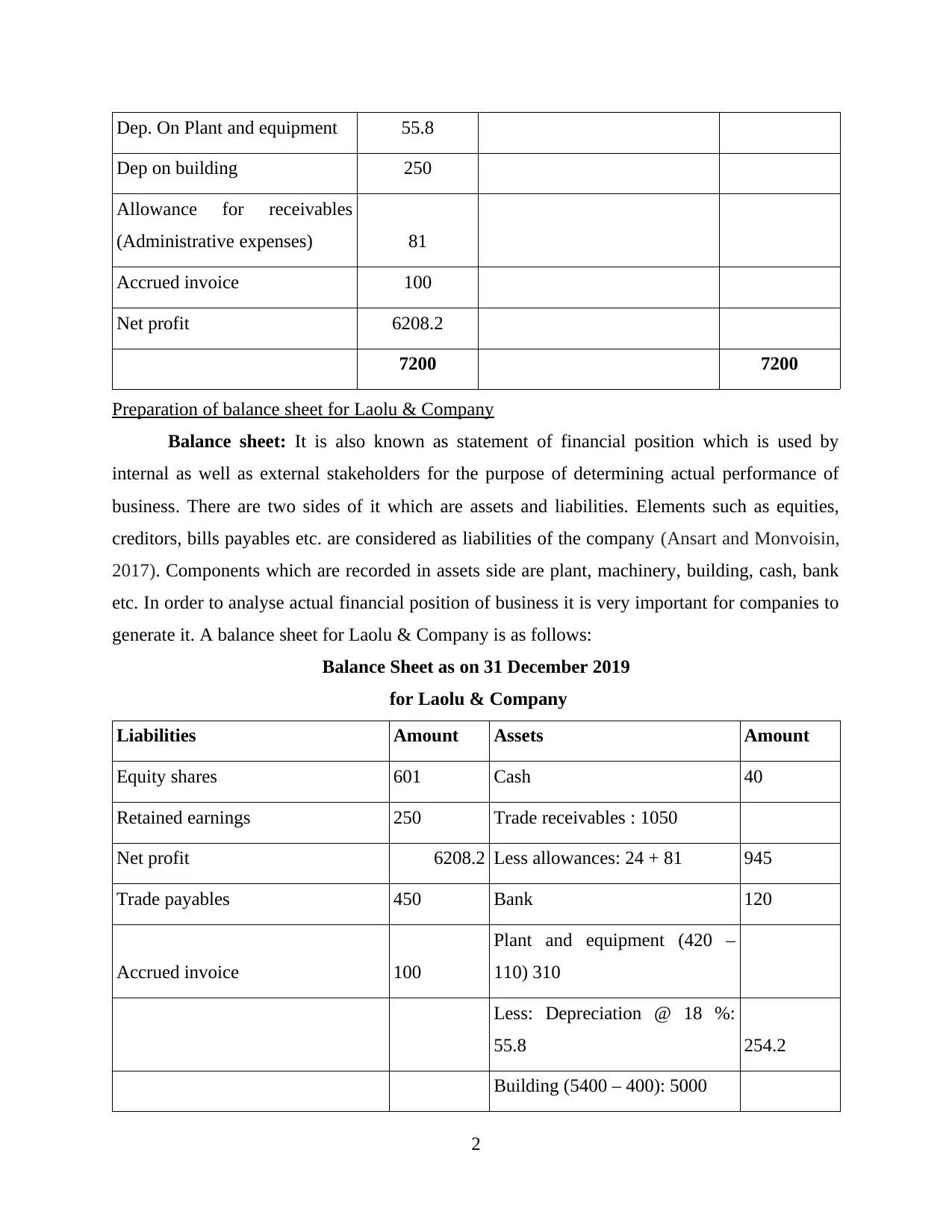
Dep. On Plant and equipment 55.8
Dep on building 250
Allowance for receivables
(Administrative expenses) 81
Accrued invoice 100
Net profit 6208.2
7200 7200
Preparation of balance sheet for Laolu & Company
Balance sheet: It is also known as statement of financial position which is used by
internal as well as external stakeholders for the purpose of determining actual performance of
business. There are two sides of it which are assets and liabilities. Elements such as equities,
creditors, bills payables etc. are considered as liabilities of the company (Ansart and Monvoisin,
2017). Components which are recorded in assets side are plant, machinery, building, cash, bank
etc. In order to analyse actual financial position of business it is very important for companies to
generate it. A balance sheet for Laolu & Company is as follows:
Balance Sheet as on 31 December 2019
for Laolu & Company
Liabilities Amount Assets Amount
Equity shares 601 Cash 40
Retained earnings 250 Trade receivables : 1050
Net profit 6208.2 Less allowances: 24 + 81 945
Trade payables 450 Bank 120
Accrued invoice 100
Plant and equipment (420 –
110) 310
Less: Depreciation @ 18 %:
55.8 254.2
Building (5400 – 400): 5000
2
Dep on building 250
Allowance for receivables
(Administrative expenses) 81
Accrued invoice 100
Net profit 6208.2
7200 7200
Preparation of balance sheet for Laolu & Company
Balance sheet: It is also known as statement of financial position which is used by
internal as well as external stakeholders for the purpose of determining actual performance of
business. There are two sides of it which are assets and liabilities. Elements such as equities,
creditors, bills payables etc. are considered as liabilities of the company (Ansart and Monvoisin,
2017). Components which are recorded in assets side are plant, machinery, building, cash, bank
etc. In order to analyse actual financial position of business it is very important for companies to
generate it. A balance sheet for Laolu & Company is as follows:
Balance Sheet as on 31 December 2019
for Laolu & Company
Liabilities Amount Assets Amount
Equity shares 601 Cash 40
Retained earnings 250 Trade receivables : 1050
Net profit 6208.2 Less allowances: 24 + 81 945
Trade payables 450 Bank 120
Accrued invoice 100
Plant and equipment (420 –
110) 310
Less: Depreciation @ 18 %:
55.8 254.2
Building (5400 – 400): 5000
2
Paraphrase This Document
Need a fresh take? Get an instant paraphrase of this document with our AI Paraphraser
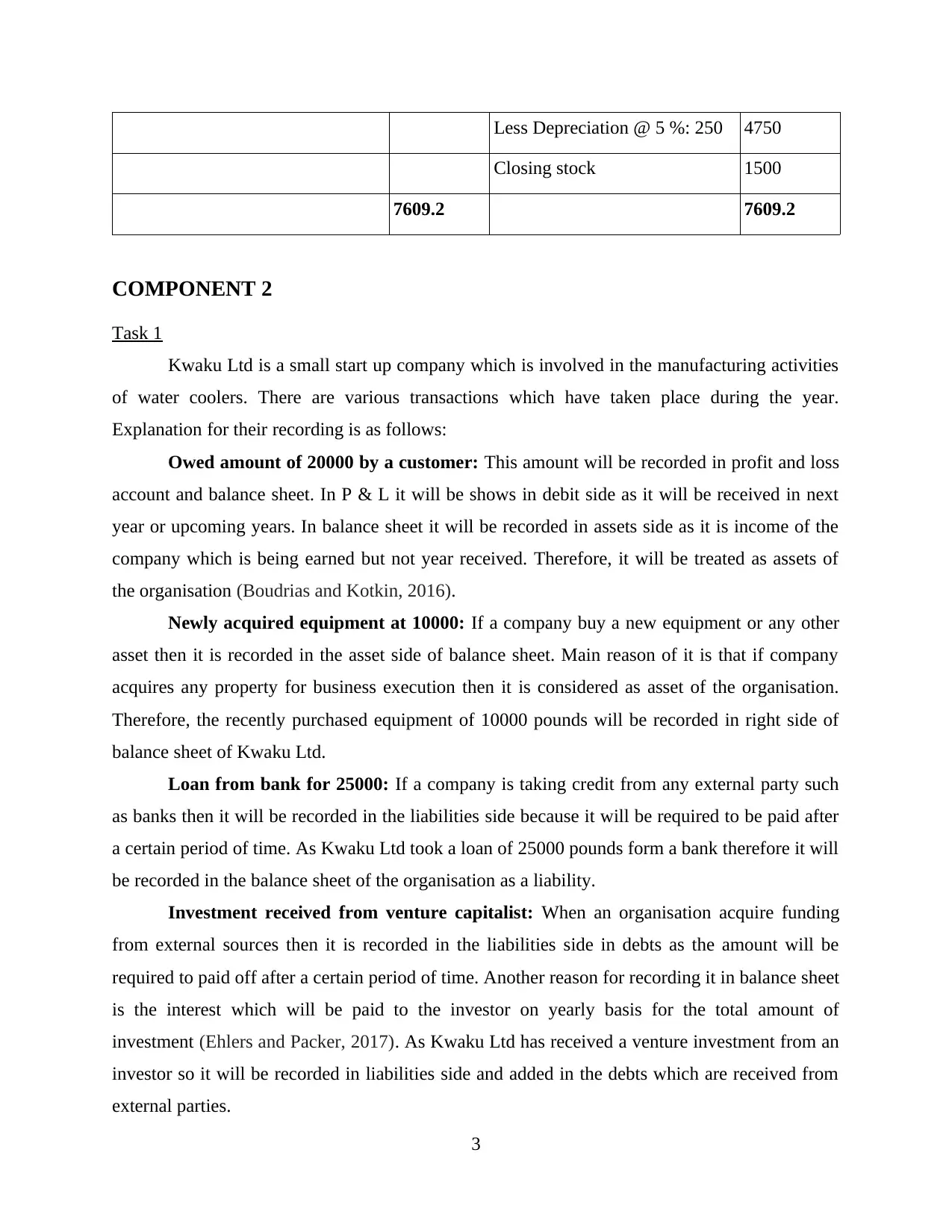
Less Depreciation @ 5 %: 250 4750
Closing stock 1500
7609.2 7609.2
COMPONENT 2
Task 1
Kwaku Ltd is a small start up company which is involved in the manufacturing activities
of water coolers. There are various transactions which have taken place during the year.
Explanation for their recording is as follows:
Owed amount of 20000 by a customer: This amount will be recorded in profit and loss
account and balance sheet. In P & L it will be shows in debit side as it will be received in next
year or upcoming years. In balance sheet it will be recorded in assets side as it is income of the
company which is being earned but not year received. Therefore, it will be treated as assets of
the organisation (Boudrias and Kotkin, 2016).
Newly acquired equipment at 10000: If a company buy a new equipment or any other
asset then it is recorded in the asset side of balance sheet. Main reason of it is that if company
acquires any property for business execution then it is considered as asset of the organisation.
Therefore, the recently purchased equipment of 10000 pounds will be recorded in right side of
balance sheet of Kwaku Ltd.
Loan from bank for 25000: If a company is taking credit from any external party such
as banks then it will be recorded in the liabilities side because it will be required to be paid after
a certain period of time. As Kwaku Ltd took a loan of 25000 pounds form a bank therefore it will
be recorded in the balance sheet of the organisation as a liability.
Investment received from venture capitalist: When an organisation acquire funding
from external sources then it is recorded in the liabilities side in debts as the amount will be
required to paid off after a certain period of time. Another reason for recording it in balance sheet
is the interest which will be paid to the investor on yearly basis for the total amount of
investment (Ehlers and Packer, 2017). As Kwaku Ltd has received a venture investment from an
investor so it will be recorded in liabilities side and added in the debts which are received from
external parties.
3
Closing stock 1500
7609.2 7609.2
COMPONENT 2
Task 1
Kwaku Ltd is a small start up company which is involved in the manufacturing activities
of water coolers. There are various transactions which have taken place during the year.
Explanation for their recording is as follows:
Owed amount of 20000 by a customer: This amount will be recorded in profit and loss
account and balance sheet. In P & L it will be shows in debit side as it will be received in next
year or upcoming years. In balance sheet it will be recorded in assets side as it is income of the
company which is being earned but not year received. Therefore, it will be treated as assets of
the organisation (Boudrias and Kotkin, 2016).
Newly acquired equipment at 10000: If a company buy a new equipment or any other
asset then it is recorded in the asset side of balance sheet. Main reason of it is that if company
acquires any property for business execution then it is considered as asset of the organisation.
Therefore, the recently purchased equipment of 10000 pounds will be recorded in right side of
balance sheet of Kwaku Ltd.
Loan from bank for 25000: If a company is taking credit from any external party such
as banks then it will be recorded in the liabilities side because it will be required to be paid after
a certain period of time. As Kwaku Ltd took a loan of 25000 pounds form a bank therefore it will
be recorded in the balance sheet of the organisation as a liability.
Investment received from venture capitalist: When an organisation acquire funding
from external sources then it is recorded in the liabilities side in debts as the amount will be
required to paid off after a certain period of time. Another reason for recording it in balance sheet
is the interest which will be paid to the investor on yearly basis for the total amount of
investment (Ehlers and Packer, 2017). As Kwaku Ltd has received a venture investment from an
investor so it will be recorded in liabilities side and added in the debts which are received from
external parties.
3
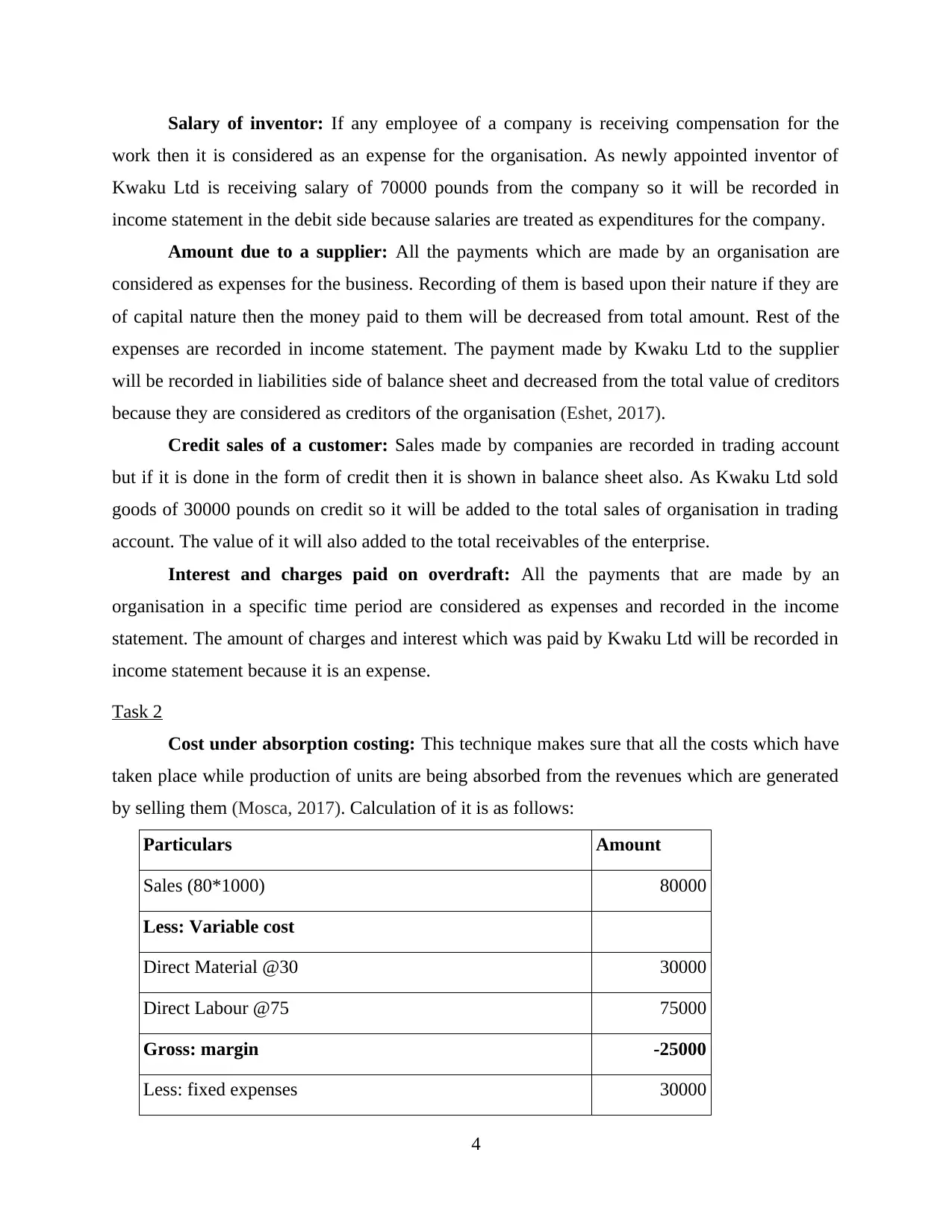
Salary of inventor: If any employee of a company is receiving compensation for the
work then it is considered as an expense for the organisation. As newly appointed inventor of
Kwaku Ltd is receiving salary of 70000 pounds from the company so it will be recorded in
income statement in the debit side because salaries are treated as expenditures for the company.
Amount due to a supplier: All the payments which are made by an organisation are
considered as expenses for the business. Recording of them is based upon their nature if they are
of capital nature then the money paid to them will be decreased from total amount. Rest of the
expenses are recorded in income statement. The payment made by Kwaku Ltd to the supplier
will be recorded in liabilities side of balance sheet and decreased from the total value of creditors
because they are considered as creditors of the organisation (Eshet, 2017).
Credit sales of a customer: Sales made by companies are recorded in trading account
but if it is done in the form of credit then it is shown in balance sheet also. As Kwaku Ltd sold
goods of 30000 pounds on credit so it will be added to the total sales of organisation in trading
account. The value of it will also added to the total receivables of the enterprise.
Interest and charges paid on overdraft: All the payments that are made by an
organisation in a specific time period are considered as expenses and recorded in the income
statement. The amount of charges and interest which was paid by Kwaku Ltd will be recorded in
income statement because it is an expense.
Task 2
Cost under absorption costing: This technique makes sure that all the costs which have
taken place while production of units are being absorbed from the revenues which are generated
by selling them (Mosca, 2017). Calculation of it is as follows:
Particulars Amount
Sales (80*1000) 80000
Less: Variable cost
Direct Material @30 30000
Direct Labour @75 75000
Gross: margin -25000
Less: fixed expenses 30000
4
work then it is considered as an expense for the organisation. As newly appointed inventor of
Kwaku Ltd is receiving salary of 70000 pounds from the company so it will be recorded in
income statement in the debit side because salaries are treated as expenditures for the company.
Amount due to a supplier: All the payments which are made by an organisation are
considered as expenses for the business. Recording of them is based upon their nature if they are
of capital nature then the money paid to them will be decreased from total amount. Rest of the
expenses are recorded in income statement. The payment made by Kwaku Ltd to the supplier
will be recorded in liabilities side of balance sheet and decreased from the total value of creditors
because they are considered as creditors of the organisation (Eshet, 2017).
Credit sales of a customer: Sales made by companies are recorded in trading account
but if it is done in the form of credit then it is shown in balance sheet also. As Kwaku Ltd sold
goods of 30000 pounds on credit so it will be added to the total sales of organisation in trading
account. The value of it will also added to the total receivables of the enterprise.
Interest and charges paid on overdraft: All the payments that are made by an
organisation in a specific time period are considered as expenses and recorded in the income
statement. The amount of charges and interest which was paid by Kwaku Ltd will be recorded in
income statement because it is an expense.
Task 2
Cost under absorption costing: This technique makes sure that all the costs which have
taken place while production of units are being absorbed from the revenues which are generated
by selling them (Mosca, 2017). Calculation of it is as follows:
Particulars Amount
Sales (80*1000) 80000
Less: Variable cost
Direct Material @30 30000
Direct Labour @75 75000
Gross: margin -25000
Less: fixed expenses 30000
4
⊘ This is a preview!⊘
Do you want full access?
Subscribe today to unlock all pages.

Trusted by 1+ million students worldwide
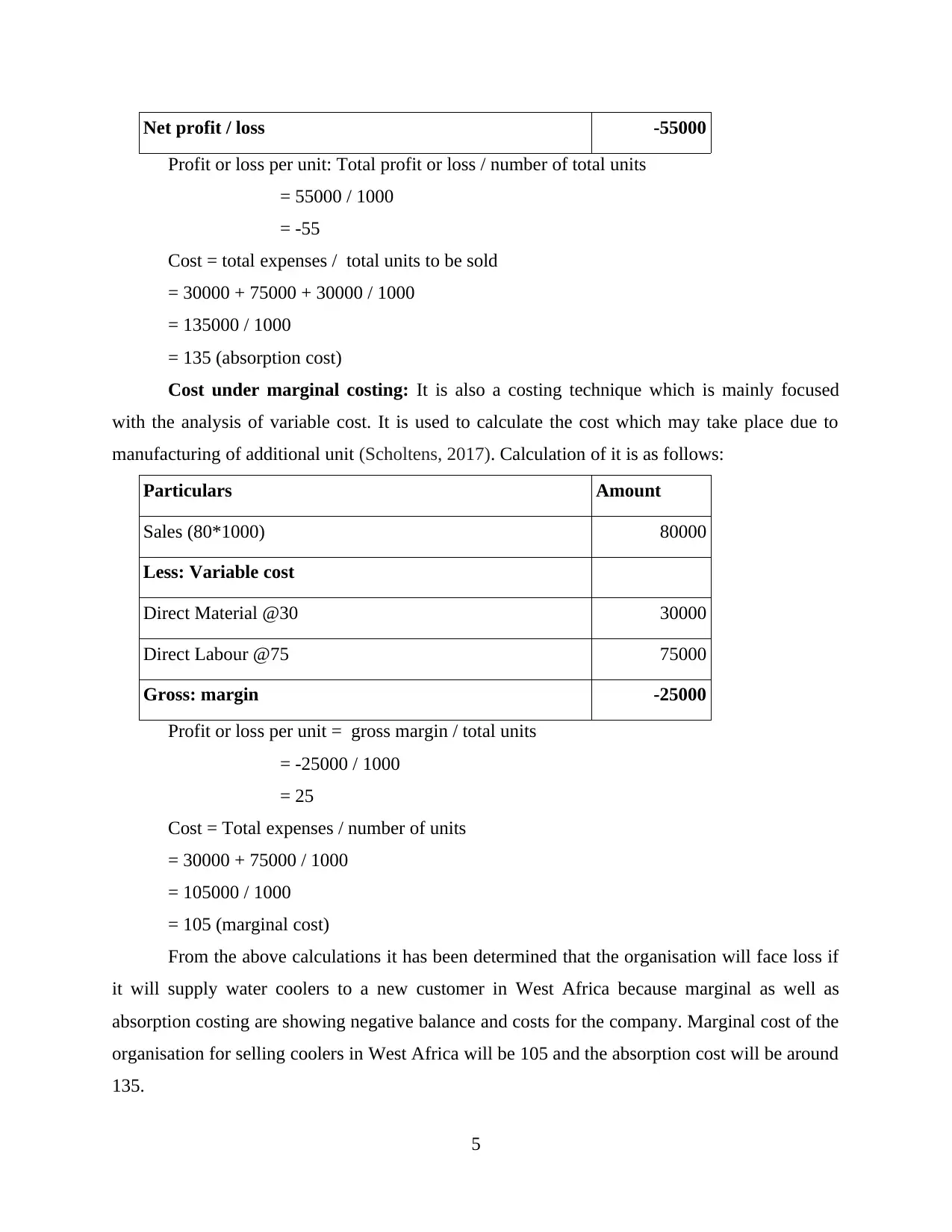
Net profit / loss -55000
Profit or loss per unit: Total profit or loss / number of total units
= 55000 / 1000
= -55
Cost = total expenses / total units to be sold
= 30000 + 75000 + 30000 / 1000
= 135000 / 1000
= 135 (absorption cost)
Cost under marginal costing: It is also a costing technique which is mainly focused
with the analysis of variable cost. It is used to calculate the cost which may take place due to
manufacturing of additional unit (Scholtens, 2017). Calculation of it is as follows:
Particulars Amount
Sales (80*1000) 80000
Less: Variable cost
Direct Material @30 30000
Direct Labour @75 75000
Gross: margin -25000
Profit or loss per unit = gross margin / total units
= -25000 / 1000
= 25
Cost = Total expenses / number of units
= 30000 + 75000 / 1000
= 105000 / 1000
= 105 (marginal cost)
From the above calculations it has been determined that the organisation will face loss if
it will supply water coolers to a new customer in West Africa because marginal as well as
absorption costing are showing negative balance and costs for the company. Marginal cost of the
organisation for selling coolers in West Africa will be 105 and the absorption cost will be around
135.
5
Profit or loss per unit: Total profit or loss / number of total units
= 55000 / 1000
= -55
Cost = total expenses / total units to be sold
= 30000 + 75000 + 30000 / 1000
= 135000 / 1000
= 135 (absorption cost)
Cost under marginal costing: It is also a costing technique which is mainly focused
with the analysis of variable cost. It is used to calculate the cost which may take place due to
manufacturing of additional unit (Scholtens, 2017). Calculation of it is as follows:
Particulars Amount
Sales (80*1000) 80000
Less: Variable cost
Direct Material @30 30000
Direct Labour @75 75000
Gross: margin -25000
Profit or loss per unit = gross margin / total units
= -25000 / 1000
= 25
Cost = Total expenses / number of units
= 30000 + 75000 / 1000
= 105000 / 1000
= 105 (marginal cost)
From the above calculations it has been determined that the organisation will face loss if
it will supply water coolers to a new customer in West Africa because marginal as well as
absorption costing are showing negative balance and costs for the company. Marginal cost of the
organisation for selling coolers in West Africa will be 105 and the absorption cost will be around
135.
5
Paraphrase This Document
Need a fresh take? Get an instant paraphrase of this document with our AI Paraphraser
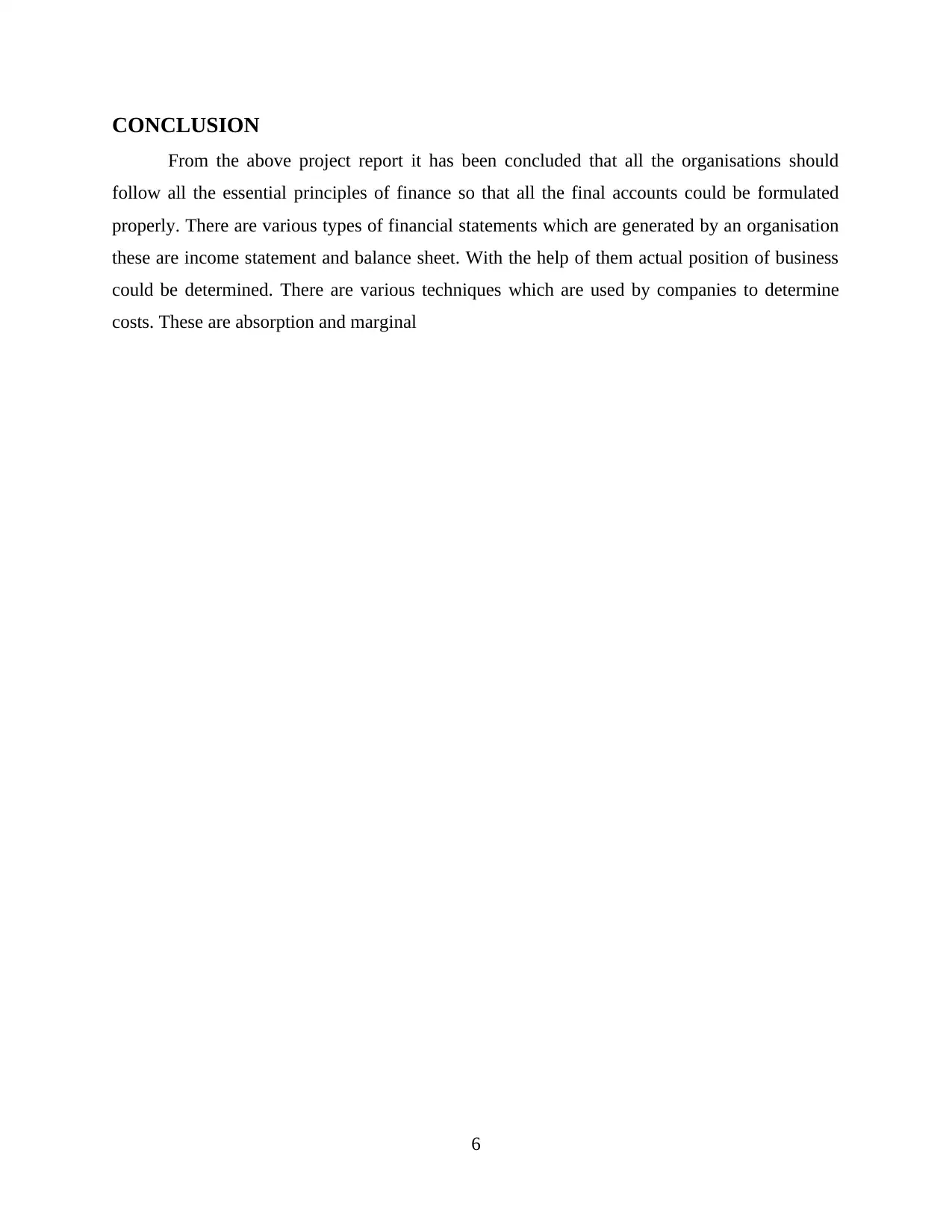
CONCLUSION
From the above project report it has been concluded that all the organisations should
follow all the essential principles of finance so that all the final accounts could be formulated
properly. There are various types of financial statements which are generated by an organisation
these are income statement and balance sheet. With the help of them actual position of business
could be determined. There are various techniques which are used by companies to determine
costs. These are absorption and marginal
6
From the above project report it has been concluded that all the organisations should
follow all the essential principles of finance so that all the final accounts could be formulated
properly. There are various types of financial statements which are generated by an organisation
these are income statement and balance sheet. With the help of them actual position of business
could be determined. There are various techniques which are used by companies to determine
costs. These are absorption and marginal
6
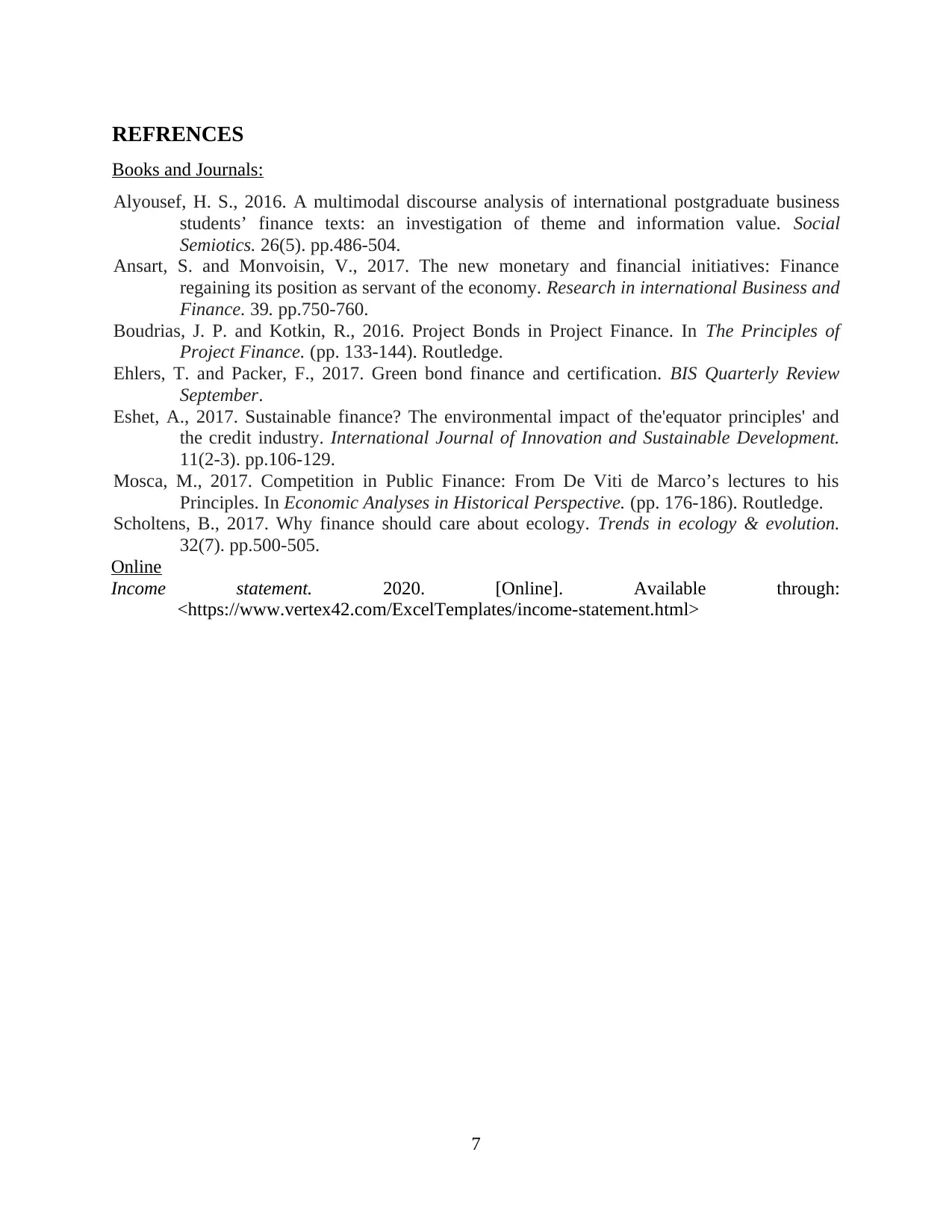
REFRENCES
Books and Journals:
Alyousef, H. S., 2016. A multimodal discourse analysis of international postgraduate business
students’ finance texts: an investigation of theme and information value. Social
Semiotics. 26(5). pp.486-504.
Ansart, S. and Monvoisin, V., 2017. The new monetary and financial initiatives: Finance
regaining its position as servant of the economy. Research in international Business and
Finance. 39. pp.750-760.
Boudrias, J. P. and Kotkin, R., 2016. Project Bonds in Project Finance. In The Principles of
Project Finance. (pp. 133-144). Routledge.
Ehlers, T. and Packer, F., 2017. Green bond finance and certification. BIS Quarterly Review
September.
Eshet, A., 2017. Sustainable finance? The environmental impact of the'equator principles' and
the credit industry. International Journal of Innovation and Sustainable Development.
11(2-3). pp.106-129.
Mosca, M., 2017. Competition in Public Finance: From De Viti de Marco’s lectures to his
Principles. In Economic Analyses in Historical Perspective. (pp. 176-186). Routledge.
Scholtens, B., 2017. Why finance should care about ecology. Trends in ecology & evolution.
32(7). pp.500-505.
Online
Income statement. 2020. [Online]. Available through:
<https://www.vertex42.com/ExcelTemplates/income-statement.html>
7
Books and Journals:
Alyousef, H. S., 2016. A multimodal discourse analysis of international postgraduate business
students’ finance texts: an investigation of theme and information value. Social
Semiotics. 26(5). pp.486-504.
Ansart, S. and Monvoisin, V., 2017. The new monetary and financial initiatives: Finance
regaining its position as servant of the economy. Research in international Business and
Finance. 39. pp.750-760.
Boudrias, J. P. and Kotkin, R., 2016. Project Bonds in Project Finance. In The Principles of
Project Finance. (pp. 133-144). Routledge.
Ehlers, T. and Packer, F., 2017. Green bond finance and certification. BIS Quarterly Review
September.
Eshet, A., 2017. Sustainable finance? The environmental impact of the'equator principles' and
the credit industry. International Journal of Innovation and Sustainable Development.
11(2-3). pp.106-129.
Mosca, M., 2017. Competition in Public Finance: From De Viti de Marco’s lectures to his
Principles. In Economic Analyses in Historical Perspective. (pp. 176-186). Routledge.
Scholtens, B., 2017. Why finance should care about ecology. Trends in ecology & evolution.
32(7). pp.500-505.
Online
Income statement. 2020. [Online]. Available through:
<https://www.vertex42.com/ExcelTemplates/income-statement.html>
7
⊘ This is a preview!⊘
Do you want full access?
Subscribe today to unlock all pages.

Trusted by 1+ million students worldwide
1 out of 9
Related Documents
Your All-in-One AI-Powered Toolkit for Academic Success.
+13062052269
info@desklib.com
Available 24*7 on WhatsApp / Email
![[object Object]](/_next/static/media/star-bottom.7253800d.svg)
Unlock your academic potential
Copyright © 2020–2025 A2Z Services. All Rights Reserved. Developed and managed by ZUCOL.





